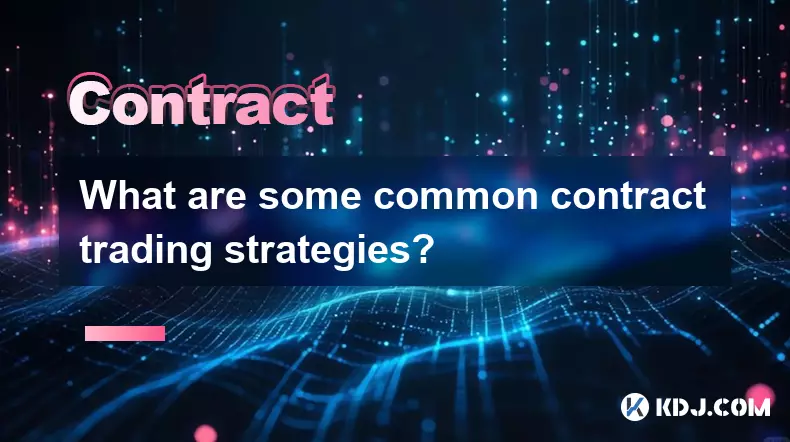-
 bitcoin
bitcoin $109547.008142 USD
0.04% -
 ethereum
ethereum $4011.838726 USD
-0.05% -
 tether
tether $1.000402 USD
-0.01% -
 xrp
xrp $2.798606 USD
0.88% -
 bnb
bnb $970.877944 USD
1.39% -
 solana
solana $202.237275 USD
-0.95% -
 usd-coin
usd-coin $0.999673 USD
0.00% -
 dogecoin
dogecoin $0.229294 USD
-1.15% -
 tron
tron $0.336370 USD
-0.45% -
 cardano
cardano $0.777260 USD
-1.66% -
 hyperliquid
hyperliquid $45.503019 USD
1.73% -
 ethena-usde
ethena-usde $1.000362 USD
0.01% -
 chainlink
chainlink $20.785303 USD
-1.10% -
 avalanche
avalanche $28.755822 USD
-0.11% -
 stellar
stellar $0.358303 USD
-0.48%
What are some common contract trading strategies?
Contract trading in crypto allows leveraged speculation on price moves via futures or perpetuals, using strategies like trend following, mean reversion, and arbitrage to manage risk and capitalize on market inefficiencies.
Sep 21, 2025 at 06:36 pm

Understanding Contract Trading in the Crypto Market
Contract trading has become a cornerstone of activity within the cryptocurrency ecosystem, allowing traders to speculate on price movements without owning the underlying asset. These financial instruments, often referred to as futures or perpetual contracts, enable participants to go long or short based on market expectations. The leverage offered amplifies both potential gains and risks, making strategy development essential for sustained success.
Trend Following Strategies
1. Identifying momentum through technical indicators is critical in trend following.1. Traders use moving averages such as the 50-day and 200-day MA to determine the direction of market momentum. When the shorter-term average crosses above the longer-term one, it may signal a bullish trend.
- The Average Directional Index (ADX) helps assess the strength of a trend. Values above 25 typically indicate a strong trend, making it favorable for contract positions aligned with the direction.
- Incorporating tools like MACD allows traders to confirm trend entries by observing crossovers between the MACD line and the signal line.
- Volume analysis supports trend validity—rising volume during price advances strengthens the case for entering long positions.
- Stop-loss orders are placed beyond recent swing lows (for longs) or highs (for shorts) to protect against sudden reversals while allowing room for normal volatility.
Mean Reversion Approaches
2. Markets often revert to average price levels after sharp deviations, creating exploitable opportunities.1. Bollinger Bands are frequently used to identify overextended price moves. When price touches or exceeds the upper or lower band, a reversal toward the middle band (simple moving average) is anticipated.
- The Relative Strength Index (RSI) helps detect overbought (>70) or oversold (
- Statistical measures like standard deviation assist in quantifying how far price has strayed from its mean, offering objective thresholds for trade execution.
- Traders may combine RSI divergence with support/resistance levels to increase confidence in reversal setups.
- Position sizing is reduced in mean reversion strategies due to the inherent risk of catching falling knives or missing continued momentum.
Arbitrage and Basis Trading
3. Price discrepancies between spot and futures markets present low-risk profit potential.1. Futures contracts often trade at a premium (contango) or discount (backwardation) relative to the spot price. Traders can exploit these differences by taking offsetting positions.
- Calendar spreads involve going long on a near-month future while shorting a far-month one when the roll yield is favorable.
- Exchange-based arbitrage occurs when the same contract is priced differently across platforms. Automated bots execute these trades within milliseconds.
- Funding rates in perpetual swaps influence basis dynamics. High positive funding incentivizes shorting the perpetual while buying spot, capturing the rate differential.
- Execution speed and low transaction costs are vital, as margins in arbitrage are typically narrow and competition is intense.
Frequently Asked Questions
What is the difference between futures and perpetual contracts?Perpetual contracts do not have an expiration date and rely on funding rates to keep their price close to the spot market. Traditional futures contracts expire on a set date and settle based on the underlying index.
How does leverage affect contract trading outcomes?Leverage multiplies both gains and losses. A 10x leveraged position will double your profit if the market moves 10% in your favor but will also wipe out your margin with a 10% adverse move, depending on liquidation thresholds.
Can algorithmic systems be used effectively in crypto contract trading?Yes, many traders deploy algorithmic strategies to automate entries, exits, and risk management. These systems operate on predefined rules using real-time data feeds and are particularly effective in high-frequency or arbitrage scenarios.
Why is risk management crucial in contract trading?Due to the leveraged nature of contracts, price swings can trigger liquidations rapidly. Proper risk controls such as stop-losses, position sizing, and portfolio diversification help preserve capital during volatile periods.
Disclaimer:info@kdj.com
The information provided is not trading advice. kdj.com does not assume any responsibility for any investments made based on the information provided in this article. Cryptocurrencies are highly volatile and it is highly recommended that you invest with caution after thorough research!
If you believe that the content used on this website infringes your copyright, please contact us immediately (info@kdj.com) and we will delete it promptly.
- XRP, Bitcoin Price Predictions: Decoding the Crypto Crossroads
- 2025-09-28 08:25:12
- ChatGPT, Crypto, and Crystal Balls: Predictions for a Wild 2025
- 2025-09-28 08:45:12
- Crypto Clash: Can Kaspa and Pi Coin Compete in a Remittix World?
- 2025-09-28 08:45:12
- Riding the Floki Wave: Gauging Gains with Social Engagement and Bottom Signals
- 2025-09-28 08:25:12
- Bitcoin's $109,000 Support: Will It Hold or Fold?
- 2025-09-28 09:05:14
- Crypto 2025: MoonBull Charges Ahead, Leaving Pepe and Mog in the Dust
- 2025-09-28 08:50:12
Related knowledge

How do I enable the "scalping-only" mode for Cardano (ADA) contracts?
Sep 24,2025 at 03:19am
Understanding Scalping Strategies in Crypto Derivatives1. Scalping in cryptocurrency trading refers to executing multiple short-term trades within min...

What is the settlement time for Cardano (ADA) contracts?
Sep 28,2025 at 04:18am
Understanding Cardano's Contract Settlement Mechanism1. Cardano operates on a proof-of-stake consensus model known as Ouroboros, which fundamentally i...

How do I add margin to Cardano (ADA) contracts?
Sep 27,2025 at 07:54pm
Understanding Margin in Cardano (ADA) Smart ContractsCardano operates on a proof-of-stake blockchain that supports smart contracts through its Plutus ...

What is the maximum position limit for Cardano (ADA) contracts?
Sep 23,2025 at 11:00pm
Understanding ADA Futures and Derivatives Market Structure1. Cardano (ADA) futures contracts are offered by several major cryptocurrency derivatives e...

What is the maker fee for Cardano (ADA) contracts?
Sep 26,2025 at 09:01am
Understanding Maker Fees in Cardano (ADA) Contracts1. The concept of maker fees applies broadly across decentralized exchanges and smart contract plat...

How can I view open interest in Cardano (ADA) contracts?
Sep 24,2025 at 07:36am
Understanding Open Interest in Cardano Derivatives1. Open interest refers to the total number of outstanding derivative contracts, such as futures or ...

How do I enable the "scalping-only" mode for Cardano (ADA) contracts?
Sep 24,2025 at 03:19am
Understanding Scalping Strategies in Crypto Derivatives1. Scalping in cryptocurrency trading refers to executing multiple short-term trades within min...

What is the settlement time for Cardano (ADA) contracts?
Sep 28,2025 at 04:18am
Understanding Cardano's Contract Settlement Mechanism1. Cardano operates on a proof-of-stake consensus model known as Ouroboros, which fundamentally i...

How do I add margin to Cardano (ADA) contracts?
Sep 27,2025 at 07:54pm
Understanding Margin in Cardano (ADA) Smart ContractsCardano operates on a proof-of-stake blockchain that supports smart contracts through its Plutus ...

What is the maximum position limit for Cardano (ADA) contracts?
Sep 23,2025 at 11:00pm
Understanding ADA Futures and Derivatives Market Structure1. Cardano (ADA) futures contracts are offered by several major cryptocurrency derivatives e...

What is the maker fee for Cardano (ADA) contracts?
Sep 26,2025 at 09:01am
Understanding Maker Fees in Cardano (ADA) Contracts1. The concept of maker fees applies broadly across decentralized exchanges and smart contract plat...

How can I view open interest in Cardano (ADA) contracts?
Sep 24,2025 at 07:36am
Understanding Open Interest in Cardano Derivatives1. Open interest refers to the total number of outstanding derivative contracts, such as futures or ...
See all articles










































































